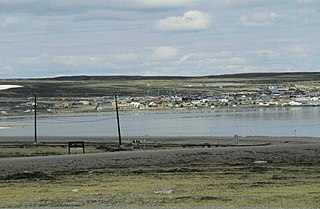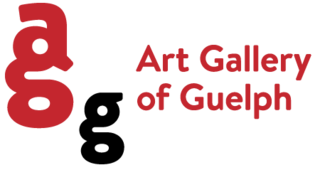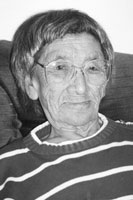Related Research Articles

Baker Lake is a hamlet in the Kivalliq Region, in Nunavut on mainland Canada. Located 320 km (200 mi) inland from Hudson Bay, it is near the nation's geographical centre, and is notable for being Nunavut's sole inland community. The hamlet is located at the mouth of the Thelon River on the shore of Baker Lake. The community was given its English name in 1761 from Captain William Christopher who named it after Sir William Baker, the 11th Governor of the Hudson's Bay Company.

Jessie Oonark, was a prolific and influential Inuk artist of the Utkuhiksalingmiut Utkuhiksalingmiut whose wall hangings, prints and drawings are in major collections including the National Gallery of Canada.
Simon Tookoome was an Utkusiksalingmiut Inuk artist.

Whale Cove, is a hamlet located 74 km (46 mi) south southwest of Rankin Inlet, 145 km (90 mi) northeast of Arviat, in the Kivalliq Region, Nunavut, Canada, on the western shore of Hudson Bay.
Irene Avaalaaqiaq Tiktaalaaq is one of Canada's most renowned Inuit artists. Her work is rooted in her lived experience, often dealing with themes of being an orphan and Inuit stories her grandmother told her. Avaalaaqiaq Tiktaalaaq is noted for her drawings, prints, and wall hangings.

The Thelon Wildlife Sanctuary, at 52,000 square kilometres (20,077 sq mi), over twice the area of Belgium, is the largest wildlife refuge in Canada. It is located in northern Canada's Arctic region, north of the tree line, straddling the Northwest Territories and Nunavut, halfway between Baker Lake and Yellowknife, and bordered on the north between the Baillie River on the west and the Consul River at the east by the Back River. It is the namesake of the Thelon River, whose river valley is resplendent with boreal forest biological diversity, hence its identification as a "Biological Site of Universal Importance" by the International Biological Program (IBP) in the 1960s.

The Art Gallery of Guelph (AGG), formerly the Macdonald Stewart Art Centre, is a public gallery and adjoining Sculpture garden in Guelph, Ontario. Its collection consists of over 9,000 works. The AGG is a nonprofit organization which focuses on research, publishing, educational programs, and touring exhibitions.

Marion Tuu'luq LL.D (1910–2002), also known as Anguhadluq, Tudluq, Tuuluq, and Toodlook, was an Inuk artist in mixed media and textiles. She "drew upon vivid colors, symmetry, and anthropomorphic imagery, to create vibrant tapestries which depict stories, legends, and personal experiences."

Janet Kigusiuq was an Inuk artist.
Sheila Butler is an American-Canadian visual artist and retired professor, now based in Winnipeg, Manitoba. She is a founding member of Mentoring Artists for Women's Art in Winnipeg, Manitoba and the Sanavik Inuit Cooperative in Baker Lake, Nunavut. She is a fellow of the Royal Canadian Academy of Arts.
Ruth Qaulluaryuk is a Canadian Inuk textile artist, also known for her drawings.
Nancy Pukingrnak Aupaluktuq is a Canadian Inuit artist known for her sculptures, drawings, and textile art. Her work draws from Inuit mythology and features Western spatial perspective.

Victoria Mamnguqsualuk (1930-2016) was one of the best-known Canadian Inuit artists of her generation.

Ulayu Pingwartok was a Canadian Inuk artist known for drawings of domestic scenes and nature.

Elizabeth Angrnaqquaq (1916–2003) was an innovative Canadian Inuk textile artist active from the 1970s to early 2000s. Angnaqquaq's work explores textile creations while experimenting with non-traditional methods. Her style has been described as painterly for the way in which she fills the space between her figures and animals with embroidery.
Luke Anguhadluq was a Canadian Inuk artist in Baker Lake.
Naomi Ityi (1928–2003) was a Canadian Inuit artist. Ityi was born in the Garry Lake area of the Nunavut. She is known for her collaged wall hangings made from wool scraps. Her sister Martha Qarliksaq is also an artist.

The UtkuhiksalingmiutUkukhalingmiut, Utkukhalingmiut —the people of the place where there is soapstone—is one of 48 groups of Inuit in what is now Nunavut, Canada. Their traditional land was around Chantrey Inlet (Tariunnuaq) area, near the estuary of the Back River in, what was then called, the Keewatin District of the Northwest Territories. The Utkuhiksalingmiut followed the traditional hunter-nomadic life moving from fishing the camp near the mouth of the Back River on Chantrey Inlet to their caribou hunting camp in the Garry Lake area, living in winter snow houses (igloos) and caribou skin tents in the summer. They subsisted mainly on trout, whitefish, and barren-ground caribou.
Jack Butler (1937-2024) was an American-Canadian visual artist. His work is in public and private collections including the National Gallery of Canada. He was a founding member of Sanavik Inuit Cooperative, Baker Lake, Nunavut. He was a medical model builder and published researcher in human development. He taught at Carnegie Mellon University, at the Banff Centre, the University of Manitoba, and in the Department of Philosophy at the University of Western Ontario.
Ada Eyetoaq (1934-2014) was a Baker Lake (Nunavut) Inuk artist who produced traditional Inuit art. She is primarily known for her miniature soapstone sculptures.
References
- ↑ William Noah Archived 2016-04-03 at the Wayback Machine at Inuit Art Alive
- ↑ "Archived copy" (PDF). Archived from the original (PDF) on 1 June 2018. Retrieved 7 March 2019.
{{cite web}}: CS1 maint: archived copy as title (link) - ↑ Nasby, Judith; Noah, William; Jackson, Marion E.; Millar, Peter (1998), "Qamanittuaq (Where the River Widens): Drawings by Baker Lake Artists From the Collection of the Macdonald Stewart Art Centre", Macdonald Stewart Art Centre, Exhibition catalogue, Guelph, archived from the original on 13 January 2015, retrieved 13 January 2015
- ↑ Mahon, Patrick. "Excerpts from the Drawn like Money Series". Highbeam Research. Archived from the original on 23 October 2017. Retrieved 30 March 2017.